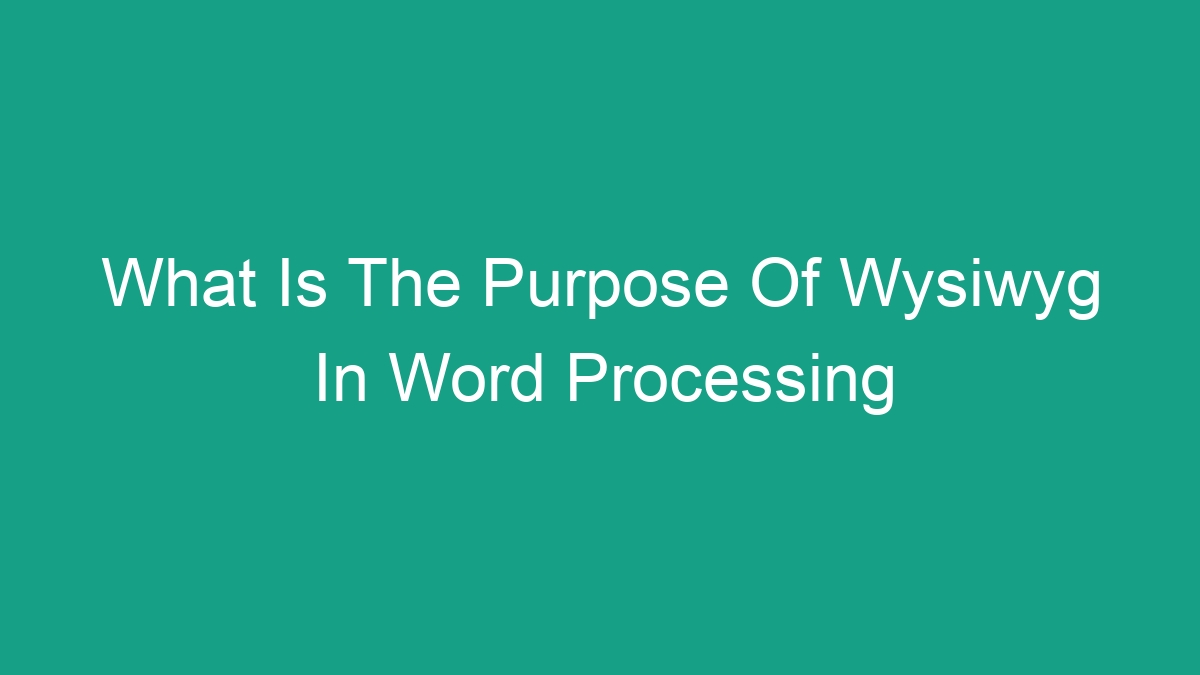
When it comes to word processing, WYSIWYG (What You See Is What You Get) is a crucial feature that has revolutionized the way we create and format documents. In this article, we will explore the purpose of WYSIWYG in word processing and its significance in modern document creation.
Understanding WYSIWYG
WYSIWYG is an acronym for What You See Is What You Get, and it refers to a type of editor that allows users to directly see the final output of their document as they are working on it. This means that the formatting and layout of the document on the screen closely resemble how it will look when it is printed or published. WYSIWYG editors are commonly used in word processing applications, allowing users to format their documents visually without the need to work with complex code or markup language.
The Purpose of WYSIWYG in Word Processing
WYSIWYG in word processing serves several important purposes:
- Accessibility: WYSIWYG editors make it easier for users to create and edit documents, especially for those who are not familiar with coding or markup languages. This accessibility allows a wider range of individuals to effectively use word processing software.
- Visual Formatting: WYSIWYG allows users to format their documents visually, making it easier to adjust the layout, font styles, and other formatting elements. This visual representation helps users to see the immediate effects of their formatting choices.
- Real-time Editing: With WYSIWYG, users can edit and format their documents in real-time, seeing the changes as they happen. This immediate feedback can be invaluable for fine-tuning the layout and appearance of the document.
- Print Preview: WYSIWYG provides a close approximation of how the document will look when printed, helping users to anticipate any layout or formatting issues before finalizing the document.
- Consistency: WYSIWYG helps to ensure consistency in the document’s appearance, as users can see exactly how their formatting choices will affect the final output.
Significance of WYSIWYG in Modern Document Creation
WYSIWYG has become an integral part of modern document creation, and its significance cannot be overstated. Here are some reasons why WYSIWYG is essential in the context of modern word processing:
- User-Friendly Interface: WYSIWYG provides a user-friendly interface that allows users to format their documents visually, without the need to learn complex programming languages or markup codes.
- Efficiency: WYSIWYG streamlines the document creation process, allowing users to see immediate results and make quick adjustments to the document’s layout and formatting.
- Professional Quality: WYSIWYG helps users to create high-quality, professional-looking documents by providing a visual representation of the final output. This ensures that the document meets the desired standards of appearance and formatting.
- Adaptability: WYSIWYG caters to a wide range of users, from beginners to experienced professionals, making it an adaptable tool for document creation across different skill levels.
- Compatibility: WYSIWYG editors are compatible with various file formats, allowing users to create and edit documents that can be easily shared and distributed without losing formatting consistency.
Conclusion
In conclusion, WYSIWYG plays a pivotal role in word processing by providing users with a visual representation of their documents as they work on them. Its accessibility, real-time editing, and print preview features make it an invaluable tool for creating and formatting documents with ease and efficiency. As modern document creation continues to evolve, WYSIWYG remains an essential component that empowers users to produce professional-quality documents with confidence.
FAQs
Q: Is WYSIWYG only used in word processing?
A: While WYSIWYG is commonly associated with word processing, it is also used in other applications such as website design, email editors, and graphic design software.
Q: Can WYSIWYG editors handle complex document formatting?
A: Yes, WYSIWYG editors are capable of handling complex document formatting, allowing users to create intricate layouts and styles with visual precision.
Q: Are there any drawbacks to using WYSIWYG in word processing?
A: While WYSIWYG offers numerous benefits, some users may find that it limits their ability to customize documents at a code level. Additionally, the visual representation in WYSIWYG may not always perfectly match the printed output, especially in more complex document layouts.



